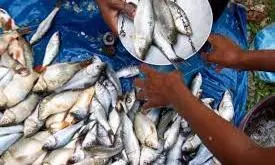
India's fish production surges to 17.5 million tons, becomes the world's second-largest producer
text_fieldsIndia’s annual fish production has nearly doubled in the last decade, reaching 17.5 million tons in 2024, with inland fishing contributing a significant 13.2 million tons, Union Fisheries Minister Rajiv Ranjan Singh announced during World Fisheries Day celebrations.
The country now ranks as the second-largest fish producer globally, accounting for 8% of the world’s total fish output, and involving approximately 30 million people across the fishing value chain.
Minister Singh attributed this growth to initiatives like the Blue Revolution, the Pradhan Mantri Matsya Sampada Yojana (PMMSY), and the Pradhan Mantri Matsya Kisan Samridhi Sah-Yojana (PMMKSY). He praised the efforts of fishermen and fish farmers for their contributions to achieving this milestone.
The minister unveiled a series of transformative projects aimed at bolstering India's blue economy. These include:
- The 5th Marine Fisheries Census for data-driven policymaking.
- National Plan of Action on Sharks, promoting sustainable shark management.
- Regional Plan of Action on Illegal, Unreported, and Unregulated (IUU) Fishing, in partnership with Sri Lanka, Bangladesh, and the Maldives, to address fishing issues in the Bay of Bengal.
- IMO-FAO GloLitter Partnership Project, tackling marine plastic pollution.
- Standard Operating Procedures (SOPs) for retrofitted LPG kits, promoting energy-efficient marine fishing.
- New Single Window System (NSWS) by the Coastal Aquaculture Authority for online registration of coastal aquaculture farms.
A Memorandum of Understanding (MoU) was also signed to introduce a Voluntary Carbon Market framework to encourage carbon-sequestering practices in the fisheries sector.
The minister highlighted the challenges of plastic pollution, water quality, carbon emissions, and infrastructural gaps in the sector. Initiatives like the Fisheries Infrastructure Development Fund (FIDF) and the integration of modern techniques were emphasized to ensure sustainable growth and strengthen India’s position as a global leader in fish production.
Speaking at the event, FAO Fisheries Division Director Manuel Barange stressed the importance of addressing hunger and malnutrition through innovative and sustainable solutions. The FAO’s Blue Transformation Initiative, focusing on sustainable aquaculture and fisheries management, was also introduced.
Awards were presented to states, districts, and individuals for their contributions to the sector.
Kerala was named Best Marine State, Telangana won Best Inland State, and Uttarakhand earned Best Himalayan and Northeastern State. Jammu & Kashmir received the award for Best Union Territory.
Notable district winners included Kollam (Kerala) for marine efforts, Kanker (Chhattisgarh) for inland fishing, Darrang (Assam) for the Himalayan region, and Kulgam (Jammu & Kashmir) for Union Territories.

















